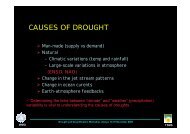training course on weather radar systems - RTC, Regional Training ...
training course on weather radar systems - RTC, Regional Training ...
training course on weather radar systems - RTC, Regional Training ...
- No tags were found...
Create successful ePaper yourself
Turn your PDF publications into a flip-book with our unique Google optimized e-Paper software.
MODULE A- INTRODUCTION TO RADAR<br />
C band <strong>radar</strong>s<br />
Those <strong>radar</strong>s operate <strong>on</strong> a wavelength of 4-8 cm and a frequency of 4-8 GHz. Because of the<br />
wavelength and frequency, the dish size does not need to be very large. This makes C band<br />
<strong>radar</strong>s affordable for TV stati<strong>on</strong>s. The signal is more easily attenuated, so this type of <strong>radar</strong> is<br />
best used for short range <strong>weather</strong> observati<strong>on</strong>. Also, due to the small size of the <strong>radar</strong>, it can<br />
therefore be portable. The frequency allows C band <strong>radar</strong>s to create a smaller beam width using<br />
a smaller dish. C band <strong>radar</strong>s also do not require as much power as an S band <strong>radar</strong>.<br />
X band <strong>radar</strong>s<br />
Those <strong>radar</strong>s operate <strong>on</strong> a wavelength of 2.5-4 cm and a frequency of 8-12 GHz. Because of the<br />
smaller wavelength, the X band <strong>radar</strong> is more sensitive and can detect smaller particles. These<br />
<strong>radar</strong>s are used for studies <strong>on</strong> cloud development because they can detect the tiny water particles<br />
and also used to detect light precipitati<strong>on</strong> such as snow.. X band <strong>radar</strong>s also attenuate very easily,<br />
so they are used for <strong>on</strong>ly very short range <strong>weather</strong> observati<strong>on</strong>. Most major airplanes are<br />
equipped with an X band <strong>radar</strong> to pick up turbulence and other <strong>weather</strong> phenomen<strong>on</strong>. This band<br />
is also shared with some police speed <strong>radar</strong>s and some space <strong>radar</strong>s.<br />
K band <strong>radar</strong>s<br />
Those <strong>radar</strong>s operate <strong>on</strong> a wavelength of .75-1.2 cm or 1.7-2.5 cm and a corresp<strong>on</strong>ding<br />
frequency of 27-40 GHz and 12-18 GHz. This band is split down the middle due to a str<strong>on</strong>g<br />
absorpti<strong>on</strong> line in water vapour. This band is similar to the X band but is just more sensitive.<br />
This band also shares space with police <strong>radar</strong>s.<br />
4.12. Polarimetric Radars<br />
Polarimetric Radars are Doppler <strong>weather</strong> <strong>radar</strong>s with additi<strong>on</strong>al transmitting and processing<br />
functi<strong>on</strong>ality to allow to further compute additi<strong>on</strong>al informati<strong>on</strong> <strong>on</strong> the directi<strong>on</strong>ality of the<br />
reflected electromagnetic energy received.<br />
Most <strong>weather</strong> <strong>radar</strong>s, transmit and receive radio waves with a single, horiz<strong>on</strong>tal polarizati<strong>on</strong>.<br />
That is, the directi<strong>on</strong> of the electric field wave crest is aligned al<strong>on</strong>g the horiz<strong>on</strong>tal axis.<br />
Polarimetric <strong>radar</strong>s, <strong>on</strong> the other hand, transmit and receive both horiz<strong>on</strong>tal and vertical<br />
40<br />
TURKEY RADAR TRAINING 1.0 / ALANYA 2005
















